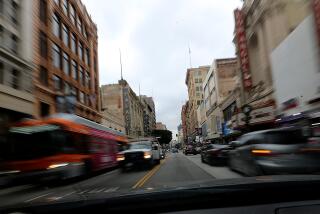TUSTIN : Survey of Historic Buildings Complete
- Share via
After two years of exhaustive research and many walks around the city, Tustin’s Cultural Resource Committee produced a survey of the city’s historic buildings.
“It was a labor of love,” said Councilwoman Leslie Anne Pontious after the report was presented to the City Council last week.
The survey identified 271 pre-1940 buildings, 94 of which were rated as “premier historic resources” on the basis of their historic significance, architectural style and uniqueness.
“Tustin has the largest amount of pre-1890 houses in Orange County,” said Diann Marsh, an architectural historian with Thirtieth Street Architects of Newport Beach, the consulting firm that prepared the survey. “There are some really rare houses, some really fine Italianate and Greek Revival houses.”
The five member committee--John Sauers, Brent Ferdig, Richard Vining, Jeff Thompson and Robert Edgell--met 13 times to complete the report.
For committee chairman John Sauers, who has lived in Tustin all his 74 years, the report brought back many memories. When he was growing up, the town was a farm community and his classmates at Tustin High School included teen-agers from Laguna Beach who arrived each day in a Pierce Arrow bus.
The survey also brought back memories for Marsh, who graduated from Tustin High in 1953.
“It’s grown so much but yet that old part is so much like it was,” Marsh said. “It’s really very charming.”
Although nearby Orange might be better known for its historic area, Tustin has far more Victorian houses--one of the most impressive collections in the county, Marsh said. The report identified 31 Victorian homes ranging in size from cottages to mansions.
In its report, the committee made several recommendations, including expanding the historic zoning district to include two areas north of 1st Street that contain a number of bungalows dating to the 1920s. The district provides a framework for preserving significant structures.
The district is generally bounded by 1st Street, 6th Street, the Costa Mesa Freeway and Prospect Avenue, roughly the same area as the original town.
The committee also recommended that the city work with residents to revitalize the downtown area.
“The downtown area is kind of dead,” Sauers said. “We kid about rolling up the sidewalks at 6 o’clock, but we want to see what we can do about it.”
At the last council meeting, Mayor Richard B. Edgar suggested setting up a town hall meeting to discuss the future of the downtown area.
The city is also in the process of forwarding the report to the State Office of Historic Preservation, City Manager William A. Huston said. With state approval of a local program, Tustin would become eligible for state and federal funds for projects such as renovations, history studies or moving historic houses.
More to Read
Sign up for Essential California
The most important California stories and recommendations in your inbox every morning.
You may occasionally receive promotional content from the Los Angeles Times.










